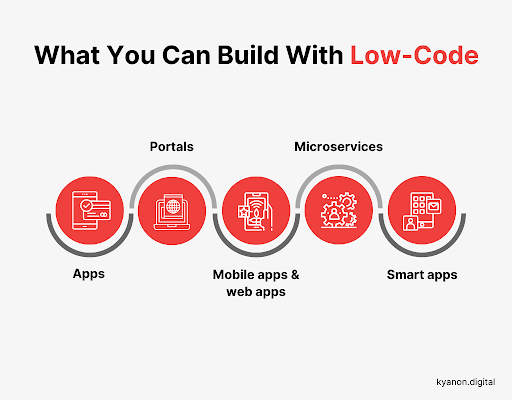Recommended Ideas For Selecting Low-Code Platform Examples
Recommended Ideas For Selecting Low-Code Platform Examples
Blog Article
In Terms Of Speed Low-Code Applications Have Many Advantages.
The development of applications using low-code significantly improves development speed because of several key factors: Visual Development Environment:
Drag-and-Drop Interfaces: Low-code platforms provide visual tools for designing applications. Developers can quickly assemble applications using drag-and-drop components without having to write code.
Pre-built Templates and Components: Many low-code platforms come with already-built templates and components which enable developers to swiftly create and prototype applications without having to start from the beginning.
Reducing Coding requirements
Automated Coding Generation: Low code platforms automatically generate code using the visual model developed by the developers. This reduces need for manual code coding.
Reusable component: Developers may make use of the same components in various projects. This reduces time spent on developing code and testing.
Collaboration is simplified:
Integrated Development Tools: Low-code platforms often contain tools for managing versions, testing, and deployment that allow seamless collaboration between development teams.
Citizen Development: People who are not developers and business users can utilize simple interfaces to help in the development of applications which can reduce bottlenecks caused by a shortage of professionals to develop applications.
Rapid prototyping and rapid iteration
Fast Prototyping Developers can quickly create prototypes of ideas that can be validated and feedback gathered, resulting to faster iteration.
Easy Modifications: The visually-oriented nature of low-code development makes it easy to make updates and changes to applications. This speeds up the process of improving and refining applications based on feedback from users.
Pre-built Integrations:
API Integrations: Low-code platforms usually have pre-built connectors for popular services and APIs, reducing the time required to integrate external systems.
Data integration tools: Tools for data integration are included to help simplify the process.
Deployment, scaling and deployment
One-Click Deployment: Many low-code platforms offer the option of deploying with one click, drastically reducing the time and effort required to deploy applications.
Cloud-Based Solutions: Cloud-based low-code platforms can manage infrastructure and scaling, allowing developers to focus on application logic and functionality rather than the logistics of deployment.
The primary benefit of developing applications using low-code with regard to speed, is its capacity to automate and simplify many aspects of the process. This allows for faster delivery of applications, and faster adaptations to evolving requirements. Follow the recommended she said about Low-code Platform for application development for more info including app dev platform, low code platforms, rad development, app modernization, develop web app, lowcode no code, rapid applications, no code platforms, mobile development platforms, application modernisation and more.
The Advantages Of Low-Code Development In Terms Of Flexibility, Scalability And Scalability
Low-code application development has many advantages when it comes to the ability to scale and flexibility. These are vital to build applications that can grow with business needs and change with the demands of business. These are the most significant advantages:
Cloud-Based Platforms: A large number of platforms that are low-code-friendly are cloud-based. They let applications easily scale up and down with the cloud infrastructure. Businesses can handle higher loads without worrying too much about server administration.
Auto-Scaling Functions: Auto-scaling features are able to adjust resources automatically according to demands. They ensure that performance is consistent in peak hours.
Flexible Architecture:
Modular Design: Low-code platforms encourage the modular design of applications. This allows components to be independently designed, tested and scalable. Modularity improves flexibility and allows to update or expand specific parts of a program without affecting the overall system.
Microservices integration: The support offered by the microservices architecture enables applications to be built as a collection of loosely coupled services. This increases scalability, and flexibility.
Solutions that can be customized:
Extensibility: Low-code platforms typically permit custom programming and scripting, allowing developers to expand the capabilities of the applications beyond the capabilities that are available in the standard. This ensures that unique business requirements can be met without constraints.
Third-Party Integrations: Integration with third-party APIs or services allows companies to add more functionality to their application.
Agile Development Deployment, Agile Development and Agile Development:
Continuous Delivery and Deployment Low-Code Platforms support agile methodologies through enabling continuous integration and Continuous Delivery (CI/CD). This allows applications to be upgraded and upgraded rapidly, in response with feedback from users.
Iterative Development: This low-code model allows applications to be improved and scaled incrementally which reduces risk and allows for a more controlled growth.
Resource Optimization
Efficiency in Resource Management: Low Code platforms can maximize resource utilization by using tools that monitor and control the performance of applications. This allows resources to be utilized efficiently and can be sized up or down based on the actual need.
Load-balancing: Features that distribute workloads equally across servers improve the application’s ability to handle massive traffic and ensure consistent performance.
Global Reach
Multi-Region: Low-code platform deployments are frequently available across multiple regions and allow businesses to provide low latency access to every user. This is especially important for apps that have a global user base.
Localization Support. Inbuilt support for localizing applications allows them to be easily adapted to different local languages, regional needs and increases their flexibility across diverse markets.
Maintenance and Updates
Simplified Maintenance : Low-code applications with a modular and visual design simplifies maintenance tasks. This lets bugs and updates to be made quickly, with no lengthy downtime.
Version Control: The integrated versions control systems permit the safe release of rollbacks and updates. Previous versions can also be restored in case they are needed.
Cost Efficiency:
Low Development Costs - Through cutting down on the amount of code required, low code platforms can reduce the development cost. This allows you to scale up applications without increasing costs and efforts to develop.
Pay-As.-You-Go Lowcode platforms have flexible pricing models, such as pay-as.-you-go. These align costs to actual usage and growth in order to give financial flexibility.
The majority of low-code application developers provide a lot of flexibility and scalability which allows companies to rapidly build robust and flexible apps. These platforms enable quick adaptations to the changing requirements, efficient resource usage, and constant enhancement. This guarantees that the application can evolve with the needs of the business. View the best Enterprise application development with Low-code Platform for site recommendations including rapid app development, develop web application, cloud software applications, jdbc server, application modernization, application modernisation, develop web app, develop web application, lowcode no code, jdbc server and more.
Benefits Of Low-Code Application Development In Terms Of Limitations And Customization
Low-code development offers a balanced approach to addressing limitations, while also allowing for the possibility of personalization. Here are the benefits:
The Challenge of Overcoming Complexity Barriers
Simplified Development: Low-code platform simplifies development by providing templates and components that are pre-built, allowing to speed up development and deployment.
A lot of platforms offer guided workflows, which help developers navigate their way through the complex processes. They minimize the risk of error and maintain uniformity.
Scalability solutions:
Built-in Scalability: Low code platforms come with a variety of options that enable an architectural design that is scalable, allowing applications to take on a greater load without significant redevelopment.
Performance Monitoring Tools: Instruments for monitoring and enhancing performance are incorporated into the application to ensure it remains efficient regardless of the size.
Security and Compliance
Integrated Security Features: Low-code systems come with built-in security measures like encryption, role-based access control and automated compliance checks to address security issues that are common.
Platforms are regularly updated with their security and compliance measures to ensure that applications are secure against threats that change.
Customization:
Extensibility:
Custom Code Integration: Low-code systems typically permit the integration of custom codes (e.g., JavaScript, Python), enabling developers to expand the capabilities beyond what is available in the standard features.
Developers can create extensions or modules to meet the specific requirements of business.
APIs and Integration:
API Support: Full API support allows seamless integration of other systems and services. This allows for extensive customization and connectivity.
Third-Party services: Low code platforms offer connectors that are designed to work with popular third-party services. This makes it simpler to build and integrate applications.
Flexible UI/UX Design
Customizable User Interfaces: Developers can modify and create user interfaces that meet branding and usability specifications, creating a tailored user's experience.
Responsive Web Design Responsive Web Design: Built-in design responsive capabilities allow applications to be customized depending on the size of the screen and the device.
Custom Business Logic for Businesses:
Visual Workflow Builds: Visual tools that allow for the customization of workflows and business rules and to design complex customized processes.
Platforms come with conditional Logic that allows the creation of custom scripts designed to deal with specific scenarios and business rules.
Data Management
Custom Data Models: Developers are able to create custom data models that meet the specific requirements of an application, and ensure that data handling is in line with business needs.
Advanced Data Processing: Integration with sophisticated tools and capabilities for data processing allow customizing how data is analyzed, and used within your application.
How do you balance customization with restrictions:
Frameworks, Standards and Standards:
Low-code platforms encourage the use of industry-standards and best practices. This results in applications of high-quality that are flexible and safe.
Governance Frameworks - Built-in governance structures ensure that customisations do not interfere with security, integrity or the observance of regulations.
Iterative development and feedback:
Rapid Prototyping: The capacity to quickly test and prototype changes allows developers to modify their designs based on feedback from users and refine the application to meet the needs of users.
Continuous Improvement: Platforms that use low-code enable continuous improvement, allowing customization and enhancement as the business requirements change.
Users Empowerment
Low-code platforms allow citizen developers to develop by allowing non-developers with intuitive interfaces, to personalize applications, they expand the pool contributors that can enhance and tailor apps.
Training and Support: Many platforms offer extensive training and support resources to help users make effective customizations without compromising the application's stability or performance.
Low-code applications offer a flexible framework that can be tailored to meet specific needs. This balance enables businesses to create and maintain applications that function, are tailored to meet their needs, and adhere to high standards of quality, security, and scaling.